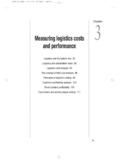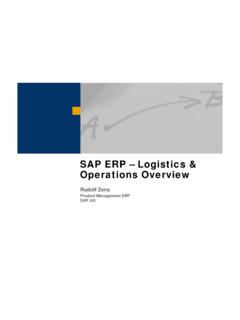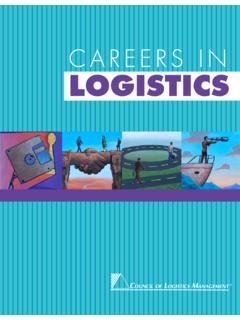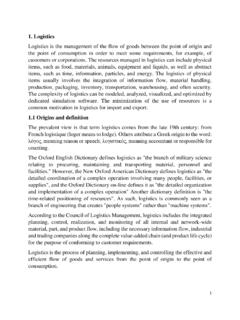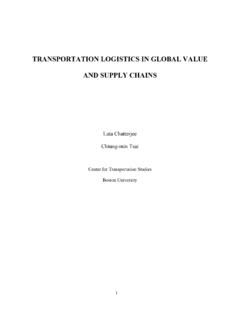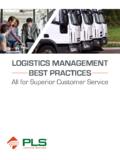Transcription of Ministry of Foreign Affairs, Singapore – Chartered ...
1 Ministry of Foreign Affairs, Singapore . Chartered Institute of logistics & Transport Singapore Executive Programme in logistics and Distribution Management Business logistics Management 9 October 2008, 9am~5pm Business logistics Management Trends and Strategies in Business logistics Strategic Supply Chain and Inventory Positioning Supply Chain Network Design Best Practices in Supply Chain Management Resource Planning and Optimisation Forecasting and Just-in-Time (JIT). Topic 1 Trends and Strategies in Business logistics Understand the importance on business logistics and its impact on the supply chain - define business logistics - know the key activities in logistics management - understand the importance of logistics /supply chain - the value added role of logistics Defining Business logistics logistics is the part of the supply chain process that plans, implements and controls the efficient, effective flows and storage of goods.
2 Services and related information from the point of origin to the point of consumption in order to meet customers'. requirements. The 3 key points to note are: - Product flows are to be managed from the point where they exist as raw materials to the point where they are finally discarded. - logistics is also concerned with the flow of services as well as physical goods, an area of growing opportunity for improvement. - logistics is a process that includes all the activities that have an impact on making goods and services available to customers as and when they wish to acquire them.
3 Key Activities of logistics Management The key activities of a typical logistics system are: Alliance between Customer Service and Marketing Transportation Inventory Management Information flows and order processing Key Activities of logistics Management Alliance between Customer Service and Marketing: To determine customer needs and wants for logistics services To determine customer responses to service To set customer service levels Key Activities of logistics Management Transportation: Mode and transport service selection Freight consolidation Carrier routing Vehicle scheduling Equipment selection Claims processing Rate auditing Key Activities of logistics Management Inventory Management: Raw materials and finished goods stocking policies Short-term sales forecasting Product mix at stocking points Number, size and location of stocking points Just-in-time, push and pull strategies Key Activities of logistics Management Information flows and order processing.
4 Sales order-inventory interface procedures Order information transmittal methods Order rules ( EOQ, Lot for Lot etc). The Importance of logistics /Supply Chain The emphasis of logistics in organisations has changed over time: Then (1980s and 1990s). Improving customer service in supply chain management was important because: Customer service contributed directly to revenue increase and market share Business logistics management was considered to be equally important with sales and marketing to produce development There was therefore a continued need for firms to reduce supply chain costs and assets as well as improve customer service for long term growth The Importance of logistics /Supply Chain The emphasis of logistics in organisations has changed over time.
5 Now The emerging view of the new century is that supply chain management can both drive and enable the business strategy of many firms. Aligning supply chain strategy with business strategy will enable value enhancement throughout the firm. The Importance of logistics /Supply Chain The emphasis of logistics in organisations has changed over time: Now Example: Dell Computer's Retail Direct involves processing orders direct from their customers, building the system to the customer's order and delivering then within 5. days. To support this logistical approach, Dell requires its suppliers to maintain inventories within 15 minutes of its manufacturing plants.
6 By unleashing the strategic power of the supply chain, Dell Computer easily outperformed its competitors in terms of shareholder value growth by over 3000 percent (taken from Stern Stewart EVA 1000 database). The Importance of logistics /Supply Chain Value According to studies conducted for the US economy, logistics costs rank second only to the cost of goods sold. Value is added by minimising these costs and passing the benefits to the customer and the firm's shareholders. Impact on cash earnings Shareholder Value is represented by Profitability (which is a relation of Revenue and Cost) and Invested Capital (represented by Working Capital and Fixed Capital).
7 Revenue Greater customer service Greater product availability Cost Lower cost of goods sold, transportation, warehousing, material handling, and distribution management costs Working Capital Lower raw materials and finished goods inventory Shorter order to cash' cycles Fixed Capital Fewer physical assets ( trucks, warehouses, material handling equipment). Worked Example J. Mitchell currently has sales of $10 million a year, with a stock level of 25% of sales. Annual holding cost for the stock is 20% of value. Operating costs (excluding the cost of stocks) are $ million a year and other assets are valued at $20 million.
8 What is the current return on assets? How does this change if stock levels are reduced to 20% of sales? Worked Example - Solution Taking costs over a year, the current position is: Cost of stock = amount of stock x holding cost = 10 million x x = $ million a year Total costs = operating cost + cost of stock = million + million = $8 million a year Profit = sales - total costs = 10 million - 8 million = $2 million a year Total assets = other assets + stock = 20 million + (10 million x )= $ million Return on assets = profit / total assets = 2 million / million = or Worked Example - Solution The new position with stock reduced to 20% of sales is.
9 Cost of stock = amount of stock x holding cost = 10 million x x = $ million a year Total costs = operating cost + cost of stock = million + million = $ million a year Profit = sales - total costs = 10 million million = $ million a year Total assets = other assets + stock = 20 million + (10 million x )= $22 million Return on assets = profit / total assets = million / 22 million = or Reducing stocks gives lower operating costs, higher profit and a significant increase in ROA. The Importance of logistics /Supply Chain Key Capabilities In the 1996 study (by Morash, Drage and Vickery) on the highly competitive US furniture industry, they identified and quantified the impact of the supply chain in profitability and growth.
10 Analysis of the survey results identified 4 key supply chain capabilities that contribute directly to financial performance. They are: 1. Delivery speed 2. Reliability 3. Responsiveness to target markets 4. Low cost total distribution Value-Added Role of logistics There are 4 principal types of economic utility that add value to a product or service, form utility, possession utility, place utility and time utility Value-Added Role of logistics Remember the What, Where, When and Why of the economic utilities What Form Utility Refers to the value added to goods through a manufacturing , production or assembly process.

